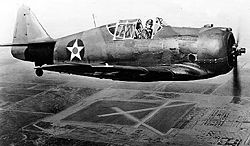North American P-64
| North American P-64 | |
|---|---|

|
|
| Type: | Fighter-bomber , trainer aircraft |
| Design country: | |
| Manufacturer: | |
| First flight: |
1939 |
| Number of pieces: |
7 NA-50A, 6 P-64 |
The North American P-64 was originally as a fighter-bomber provided training aircraft of the US manufacturer's North American from the late 1930s.
history
The development of the P-64 was based on the premise of developing a relatively simple fighter aircraft for export to smaller countries. The aircraft should still have modern construction details such as a closed cockpit and a retractable undercarriage. The starting point for development was the experimental North American NA-16 monoplane trainer aircraft from 1935, from which a whole family of military aircraft was derived. The NA-26 was one of these developments. From this two-seater design, single-seater variants were then also designed.
NA-50
Their first was the NA-50A, which was also the first to receive a retractable undercarriage and was built for the Peruvian Air Force. The NA-50A received an 870 hp Wright R-1820-77 air-cooled radial engine and an armament of two 0.30-in-Colt-Browning machine guns. The top speed was 470 km / h (295 mph) at 2900 m (9500 ft.), The range was 1030 km (645 mi.). By May 1939, Peru received seven of them, which were equipped there with dropping devices for light bombs. During the fighting between Peru and Ecuador in 1941 , the NA-50A flew some sorties. Two machines were lost in the process.
NA-68

In November 1939, the Thai Air Force ordered six fighters that differed only slightly from the Peruvian NA-50A. Designated as NA-68, they had reinforced armament, modified tail surfaces, as they were later also used for training aircraft variants, a longer engine fairing and a reinforced landing gear. The six machines were on their way to Thailand in Hawaii when Japanese troops attacked Thailand in December 1941 . The American government then confiscated the aircraft and had them brought back to the United States. There the armament was expanded and the NA-68 was put into service under the USAAC designation P-64 as an advanced trainer aircraft at Luke Field in Arizona . Two crashed there, the rest were distributed to the four Training Command headquarters and used there by officers as personal machines.
Comparable development
The NA-68 can be compared to the Commonwealth CA-12 Boomerang developed in Australia , which is also a further development of the original NA-16 trainer aircraft.
Technical specifications
| Parameter | Data NA-68 |
|---|---|
| crew | 1 |
| length | 8.24 m |
| span | 11.36 m |
| Wing area | 21.13 m² |
| Empty mass | 2120 kg |
| Max. Takeoff mass | 3087 kg (normal: 2720 kg) |
| Top speed | 430 km / h at 2650 m |
| Service ceiling | 8380 m |
| Range | 1000 km at 376 km / h maximum 1500 km |
| Engines | a Wright R-1820 -77 Cyclone nine-cylinder radial engine with 950 PS (708 kW) |
| Armament | two 0.3-in machine guns, two 20-mm machine guns, four 45-kg bombs |
Received aircraft
The only surviving P-64 is on display in the EAA AirVenture Museum ; it flew again for the first time on June 17, 2016 after 30 years on the ground.
See also
literature
- William Green: Warplanes of the second world war - Fighters, Volume four. 3. Edition. McDonald, London 1965, p. 134 f.
- North American P-64 - Preservation Profile No 58 . In: Airplane Monthly February 1978, p. 94 f.
- North American P-64 . In: AERO - The illustrated collective work of aviation, Issue 123, 1985, p. 3443
- North American NA-68 (P-64) - Fighter AZ . In: AIR International April 1989, p. 184
Web links
Individual evidence
- ↑ 1940 North American P-64 / NA-50 - N840. Location: Eagle Hangar. In: EAA Museum. Experimental Aircraft Association, accessed October 14, 2017 .
